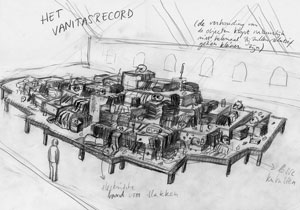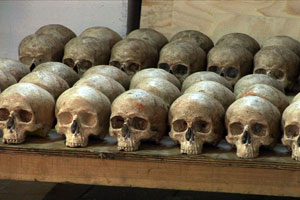|
“ … Koen Theys filmed The Vanitas Record and it turned out to be a masterpiece. ..”
Mark Ruyters - De Tijd
entire article (NL)
“ … But the difference between this contemporary vanitas, brought to superlatives, and the classical vanitas, lays in this excessive accumulation of objects …”
Marie-Claude Lambotte – Les Vanités dans l’Art Contemporain
entire article (FR)
“ … but never before did he touch on it so directly as in The Vanitasrecord. A motive which keeps coming back is the ‘fantastic’ - though in a Kafkaesque sense : a theme is carried through to such an extreme, that it begins to turn on itself. To Theys it is a way to visualise certain impossibilities or dilemmas in contemporary art…”
Stoffel Debuysere – Arts numériques
entire article (NL) (EN)
"The Belgian artist Koen Theys built an impressive vanitas-still life ("the biggest in the world"), a wooden construction (20m. by 16m.) crammed with skulls, candles and books along with thousands of live snails…”
Kunsthal Rotterdam – presstext
entire article (EN)
“ … Actually, I think this work of Koen Theys is the most sensible, one that speaks best of what a real vanity is. …”
Yondas – Untitled Paris
entire article (FR)
“ … The conversations follow one another and overlap one another, making the installation say one thing and than its opposite. …”
Caroline Champion & Samuel Zarka – Exploratrice des Saveurs
entire article (FR)
“ The video of Koen Theys is extraordinary, not because of his Book of Records characteristics (The biggest Vanity in the world!) but because of everything it contains. … “
Onar Retetout - Main Tenant
entire article (FR)
“ … It was a sight and scent never to forget. Snails hanging from clocks and candles, symbols of transience. Snails in the empty eyes of the skulls, symbol for the inevitable death. And snails that agonizingly slowly ate Nietzsche, Hegel, Sartre, ... as a symbol of vanity and pride… “
Daan Ballegeer - De Tijd
entire article (NL)

Storyboard

Set's Photos
|



